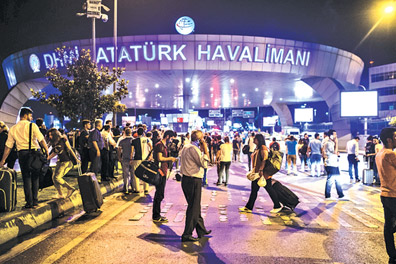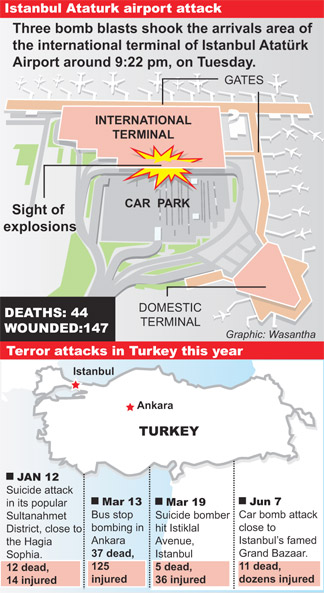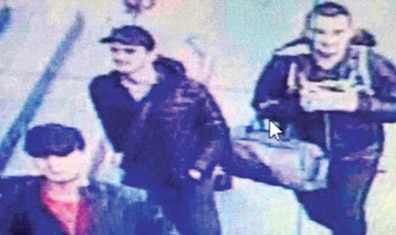Istanbul: tactics of urban terror
To Sri Lankans, already familiar with the urban
guerilla strikes in their own cities, the methods and style of the
Istanbul attack may seem déjà vu.:
by Dilshan Joseph
 Global aviation travel is at its zenith today as people travel
thousands of miles on business and leisure. Therefore, airports have
become more crowded, with a mix of foreigners. This is a prime reason
for airports to be selected for terrorist attacks as they yield a higher
death toll and worldwide media publicity. Since proclaiming a worldwide
Islamic Caliphate in 2014, ISIL (Islamic State of Iraq and the Levant
with origins dating to 1999) continues to dominate certain regions of
the world, and unleash violent terror attacks. Global aviation travel is at its zenith today as people travel
thousands of miles on business and leisure. Therefore, airports have
become more crowded, with a mix of foreigners. This is a prime reason
for airports to be selected for terrorist attacks as they yield a higher
death toll and worldwide media publicity. Since proclaiming a worldwide
Islamic Caliphate in 2014, ISIL (Islamic State of Iraq and the Levant
with origins dating to 1999) continues to dominate certain regions of
the world, and unleash violent terror attacks.
During this holy month of Ramadan, one must remember that millions of
Muslims live in peace all over the world and have contributed immensely
to their respective societies, drawing from their magnificent heritage
from the lands of the Fertile Crescent. As renowned Islamic scholar
Dr.Zakir Naik often says on Television, 'Islam is a tolerant and
peaceful religion".
Changed the pattern
 Ataturk Airport in Istanbul, Turkey is the third busiest airport in
Europe. In this incident it is noteworthy that the suspected ISIL
members have changed their normal attack pattern of suicide explosions.
The three men had managed to come to the first checkpoint of the
airport. When subject to the usual X-ray scan they realized that they
had been "given away" and began to fire into the crowd with AK 47
assault rifles. A gallant policeman on duty grappled with one gunman,
until the gunman detonated his deadly suicide vest. Meanwhile, other
security staff opened fire on the two remaining gunmen who also exploded
themselves. At present, there are 44 dead and 239 injured and
hospitalized. In 2001, the US Federal Aviation Administration (FAA)
awarded Istanbul's airport for being the safest Airport in the Middle
East and the Balkans. Ataturk Airport in Istanbul, Turkey is the third busiest airport in
Europe. In this incident it is noteworthy that the suspected ISIL
members have changed their normal attack pattern of suicide explosions.
The three men had managed to come to the first checkpoint of the
airport. When subject to the usual X-ray scan they realized that they
had been "given away" and began to fire into the crowd with AK 47
assault rifles. A gallant policeman on duty grappled with one gunman,
until the gunman detonated his deadly suicide vest. Meanwhile, other
security staff opened fire on the two remaining gunmen who also exploded
themselves. At present, there are 44 dead and 239 injured and
hospitalized. In 2001, the US Federal Aviation Administration (FAA)
awarded Istanbul's airport for being the safest Airport in the Middle
East and the Balkans.
The three gunmen had come in a taxi, and many now opine that vehicle
entry check failed to identify the concealed assault rifles. Taking a
common taxi also tends to relax some checking as security guards may
often be suspicious of a tinted black vehicle. Loose (baggy) clothing
and jackets in foreign nations makes it easy to conceal a suicide vest,
pistol or even an automatic gun like the Uzi. The gunmen came from
Russia, Uzbekistan and Kyrgyzstan. Intelligence and security analyst of
Kings College, London Mr. Fredric Baum commented that this deadly
onslaught was the work of trained and experienced terrorists. Ataturk
Airport's International Terminal boasted a total of 38.2 million
passengers in 2014.
The choice of weapon clearly shows that the gunmen desired to kill as
many as possible, whilst the shooting rampage also tends to terrorize
crowds who would run helter skelter to escape. The AK 47 is an automatic
assault rifle made in 1949, for the Soviet Union. Some models still use
a 7.62 cartridge (M67 variety) and in fully automatic mode releases a
fiery outburst of 100 rounds per minute, cycling fresh rounds into the
chamber. This enabled the gunmen to take 44innocent lives in a
relatively short firefight.
 This attack is a clear indication that ISIL has gone onto an
offensive mode 'taking their fight' into nations that despise and outlaw
them. This is a classic case of the Ideological Killer, though it
deviates in one point that the gunmen were ready to die. The motive here
defers from the recent club shootings in Florida, where Omar Mateen was
a solitary Active Shooter claiming 49 lives. This attack is a clear indication that ISIL has gone onto an
offensive mode 'taking their fight' into nations that despise and outlaw
them. This is a classic case of the Ideological Killer, though it
deviates in one point that the gunmen were ready to die. The motive here
defers from the recent club shootings in Florida, where Omar Mateen was
a solitary Active Shooter claiming 49 lives.
New challenge
Aviation security worldwide now faces a new challenge as the inside
of the airports are well secured with armed guards and CCTV
surveillance. The outer perimeter will now have to be extended, perhaps
with 2 or 3 perimeter defences before entering the main terminals. A
brilliant example of Terminal approach defense upgrade is our own
Katunayake Airport where the terminal walkways are quite long, and could
therefore restrain and mitigate an attack of this nature at the first
entrance check point, giving those inside the terminal, time to escape.
ISIS terror strategies will continue to evolve and terrorists may
even use airborne attacks (ie helicopters) to breach ground security
using the advantage of the air ceiling and can load the chopper with
explosives and directly ram it into a parked aircraft or terminal for an
extensive kill. Helicopters and single engine planes are very common
aeriel vehicles in advanced countries with many civil pilots. Former
Head of Security at Heathrow Airport, Norman Shanks reckons that crowds
at airports will always attract acts of terror. He also suggests that
advanced face recognition systems will help identify suspects via CCTV
as they enter the first gates. Often, security checks of airport staff
and flight crews are not very strict and emphasis must be given to
subject them to the same routine of passengers.
Examining loads of baggage is indeed a challenge and puts great
stress on security staff. One has to then deal with the threat of
poisonous gas which can be fed via cooling systems and kill in seconds.
Hence, terminal ventilation systems must meet tough security compliance
and routine maintainence. The passenger will require more time and
patience to check- in, in future. Air cargo needs to be double checked
prior to loading. Cyber attacks may also paralyze a Control tower,
putting flight operations into chaos. Finally, airports must be upgraded
to detect CBRNE- Chemical, Biological, Radiological, Nuclear and
Enhanced Conventional Weapons with trained first responders.
Brutality
British philosopher, Jonathan Glover once noted the human species is
fascinated with inflicting brutality on itself. This analysis has now
been endorsed by such violent attacks. A suicide bomber behaves like a
rational actor (Coleman and Rosenberg 2009). According to an estimate by
the CIA the combat ready forces of ISIL in Iran and Syria stand at
31,000 fighters, with a majority being foreigners. The foreign mix aids
would be bombers to easily blend into places like resorts, convention
centres and airports, as they don't fit a text book type terrorist
profile. Intelligence reports indicate that about 3,400 ISIL fighters
are from Western Nations. The outfit continues its 'psychological
warfare' by displaying brutally graphic beheadings.
The Philippines based group Isnilon Totoni Hapilon swore steadfast
allegiance to the Islamic Caliphate and its Leader, Abu Bakr al-Baghdadi
in 2014. Subsequently, they began to abduct people for ransom, to fund
their ongoing operations.
This paved the way, in 2015, for the formation of Ansar Khalifa in
the Philippines. ISIS agents and members of 'sleeping cells' have been
able to convince and enlist 500 combatants from Pakistan, 200 from
Malaysia and 500 from Indonesia, according to a UN report. According to
TRAC (Terrorism Research & Analysis Consortium) the Jundallah (soldiers
of god) group in Pakistan has strong bonds with ISIS.
The Turkey attack is a tactical shift of the ISIS. Our neighbour
India, has come under the spotlight with 18 of their citizens being in
ISIS ranks and 43 Sri Lankans are suspected to be combatants for ISIS in
the Syrian region.
According to counter terrorism expert Professor Rohan Gunaratne, the
ISIS affiliated volunteers may increase in the future after being
radicalized.
The defiant Caliphate has a list of nations they desire to invade by
2020; Sri Lanka and India are also on the list as stated by Andrew
Hosken of the BBC.
Given this backdrop, it is paramount that our law enforcement and
intelligence agencies work together, to filter and mitigate such future
threats that may even target Sri Lanka.
|

